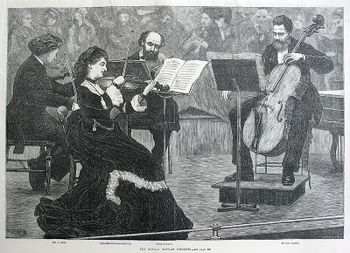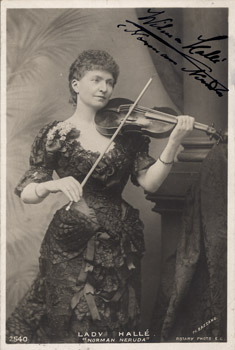Annotation:Madam Neruda: Difference between revisions
No edit summary |
m (Text replacement - "garamond, serif" to "sans-serif") |
||
| (4 intermediate revisions by one other user not shown) | |||
| Line 1: | Line 1: | ||
=='''Back to [[{{BASEPAGENAME}}]]'''== | =='''Back to [[{{BASEPAGENAME}}]]'''== | ||
---- | ---- | ||
<p><font face=" | <p><font face="sans-serif" size="4"> | ||
'''MADAM NERUDA.''' Scottish, Hornpipe. E Flat Major. Standard tuning (fiddle). AABB. | '''MADAM NERUDA.''' Scottish, Hornpipe (2/4 time). E Flat Major. Standard tuning (fiddle). AABB. An arpeggio movement in E Flat composed by fiddler-composer and dancing master [[Biography:J. Scott Skinner]] (1843-1927) in honor of Wilhelmina Neruda [http://en.wikipedia.org/wiki/Wilma_Neruda] (1838-1911), Lady Hallé, a celebrated concert violinist of the Victorian era who made her first public appearance as a violinist in Vienna at the age of seven, playing one of Bach's Violin Sonatas. The Moravian-born Neruda became Lady Hallé when she married Sir Charles Hallé, founder of the famous English orchestra, and was considered one of the premier violinists of her generation, particularly when she lived in England. Upon her husband's death she moved to Italy to be near her son, a renowned Aplinist, and after his death while climbing in the the Dolomites, she moved to Berlin, where she died. Skinner recorded the tune in the 1920's as part of his "Celebrated Hornpipes" medley. | ||
[[File:neruda2.jpg| | [[File:neruda2.jpg|350px|thumb|right|Neruda in a string quartet]] | ||
Sir Arthur Conan Doyle wrote of Sherlock Holmes attending one of her concerts in his story "A Study in Scarlet". | Sir Arthur Conan Doyle wrote of Sherlock Holmes attending one of her concerts in his story "A Study in Scarlet". | ||
[[File:neruda.jpg| | [[File:neruda.jpg|300px|thumb|left|Madame Neruda]] | ||
<br> | <br> | ||
<br> | <br> | ||
</font></p> | </font></p> | ||
<p><font face=" | <p><font face="sans-serif" size="4"> | ||
''Source for notated version'': | ''Source for notated version'': | ||
<br> | <br> | ||
<br> | <br> | ||
</font></p> | </font></p> | ||
<p><font face=" | <p><font face="sans-serif" size="4"> | ||
''Printed sources'': Hardie ('''Caledonian Companion'''), 1992; | ''Printed sources'': Hardie ('''Caledonian Companion'''), 1992; p. 127. Skinner ('''The Logie Collection'''), 1888; p. 106. | ||
<br> | <br> | ||
<br> | <br> | ||
</font></p> | </font></p> | ||
<p><font face=" | <p><font face="sans-serif" size="4"> | ||
''Recorded sources'': <font color=teal>Flying Fish FF 70572, Frank Ferrel - "Yankee Dreams: Wicked Good Fiddling from New England" (1991). Great Meadow Music GMM 2002, Rodney Miller & David Surette - "New Leaf" (2000).</font> | ''Recorded sources'': <font color=teal>Flying Fish FF 70572, Frank Ferrel - "Yankee Dreams: Wicked Good Fiddling from New England" (1991). Great Meadow Music GMM 2002, Rodney Miller & David Surette - "New Leaf" (2000).</font> | ||
</font></p> | </font></p> | ||
Latest revision as of 14:18, 6 May 2019
Back to Madam Neruda
MADAM NERUDA. Scottish, Hornpipe (2/4 time). E Flat Major. Standard tuning (fiddle). AABB. An arpeggio movement in E Flat composed by fiddler-composer and dancing master Biography:J. Scott Skinner (1843-1927) in honor of Wilhelmina Neruda [1] (1838-1911), Lady Hallé, a celebrated concert violinist of the Victorian era who made her first public appearance as a violinist in Vienna at the age of seven, playing one of Bach's Violin Sonatas. The Moravian-born Neruda became Lady Hallé when she married Sir Charles Hallé, founder of the famous English orchestra, and was considered one of the premier violinists of her generation, particularly when she lived in England. Upon her husband's death she moved to Italy to be near her son, a renowned Aplinist, and after his death while climbing in the the Dolomites, she moved to Berlin, where she died. Skinner recorded the tune in the 1920's as part of his "Celebrated Hornpipes" medley.

Sir Arthur Conan Doyle wrote of Sherlock Holmes attending one of her concerts in his story "A Study in Scarlet".

Source for notated version:
Printed sources: Hardie (Caledonian Companion), 1992; p. 127. Skinner (The Logie Collection), 1888; p. 106.
Recorded sources: Flying Fish FF 70572, Frank Ferrel - "Yankee Dreams: Wicked Good Fiddling from New England" (1991). Great Meadow Music GMM 2002, Rodney Miller & David Surette - "New Leaf" (2000).
